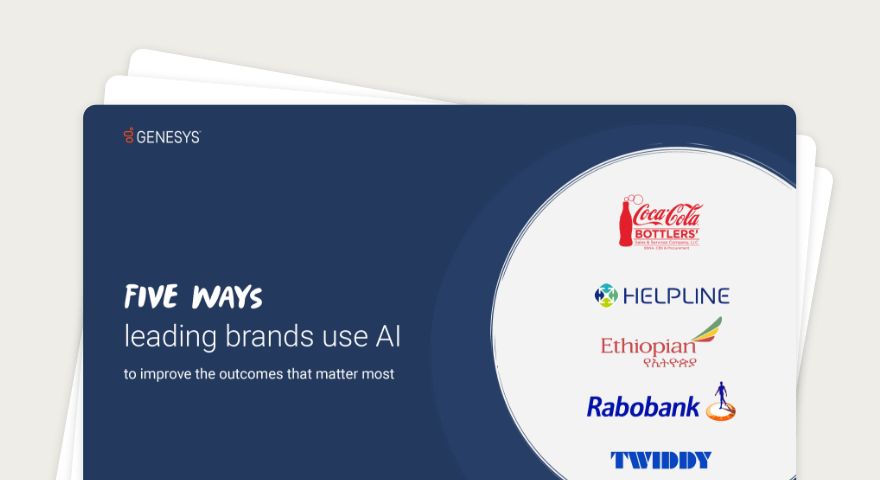Your Genesys Blog Subscription has been confirmed!
Please add genesys@email.genesys.com to your safe sender list to ensure you receive the weekly blog notifications.
Subscribe to our free newsletter and get blog updates in your inbox
Don't Show This Again.

Judging by recent AI news, generative AI is the only form of AI that matters — and it’s the only one that’s relevant for customer and employee experience outcomes. Generative AI is certainly a transformational form of artificial intelligence (AI) and having generative AI in your contact centre toolset is critical in this content-hungry business environment. However, the ability to transform content and create more content isn’t the only relevant use case.
In the data science community, certain techniques have stood the test of time. The top three algorithms that are used have not changed over the past decade: linear regression, logistic regression and decision trees. These algorithms are used the most because they answer critical questions: “What is going to happen next? And why?”
Within the contact centre, AI has been used to predict and automate key processes, with proven ROI, well before generative AI was a possibility.
Predictive AI techniques are used to calculate an outcome based on learned data patterns. For example, predictive AI is used to calculate the propensity to buy for a specific customer based on the buying behaviours of the many customers that have made a purchase before. It can also be used to group customers into segments and while segmentation technically uses clustering and grouping algorithms (versus the classical predictive algorithms), it can be based on predicted outcomes.
When predictive AI is used for intelligent automation, it can call upon its closest AI cousin – prescriptive AI. Prescriptive AI is sometimes invoked when there’s a decision to be made and there are multiple options that are possible. For example, Genesys Predictive Routing uses both predictive and prescriptive techniques to automate customer-agent connections based on a predictive model that’s automatically created through Genesys AI.

Find out how five leading companies use AI to increase customer and employee satisfaction, improve efficiency and transform their CX.
When a customer chooses to activate predictive routing, they select a KPI they want to optimise. They can choose an operational KPI, such as average handle time, or they can select a revenue KPI like “Sales.” Once the KPI is selected, Genesys AI evaluates the hundreds of possible factors that could be driving that KPI based on agent profile, customer profile, interaction profile and more.
Before a customer chooses to implement this new routing protocol, Genesys AI uses a form of prescriptive AI for a benefit assessment. Prescriptive AI is defined as a form of AI that uses data to determine the best possible action based on multiple factors. The benefit assessment is a unique application of AI that shows customers’ potential KPI impact. When applied, predictive routing has an almost immediate impact on KPIs — it’s built for that from the ground up.
Using a prediction for automation is one application of this form of AI within the contact centre, but it’s not the only one. The ability to predict an outcome creates new opportunities for people and systems to learn about what a customer — or an employee — is likely to do next. One advantage of the contact centre is the vast amount of data that’s created.
The ability to turn this data into insights requires some core capabilities:
Predictive AI can be used in the following ways:
Conversational AI is a new bedrock of the modern contact centre. Automatic conversations, virtual assistants, bots — these are all ways of delivering smart self-service across all forms of engagement channels. What started as IVR (Press 1 for Yes, 2 for No) has evolved into the ability for consumers to interact with a brand using their own language and their own words — and to receive support on their own terms.
While predictive AI is a staple, conversational AI is a form of the technology that emerged to help automate conversations. Conversational AI has the same roots as generative AI, but a different focus. It’s used for bots and within IVRs to enable natural, controlled conversations between customers and brands.
Blending conversational AI with predictive AI enables the architect to personalise conversations based on insight that isn’t readily available. For example, if a customer has shared their personal data, it’s easy to add a name greeting — and potentially extend that level of personalisation based on other easy-to–identify characteristics.
Conversations can go like this:
“Hello Bob!” or “Hello Bob! Hope you’re having a pleasant morning.”
“Hello Sally! Hope you’re having a nice afternoon.”
With predicted insight blended into the conversation, we now have:
“Hello Bob! Good morning! Can I help you find a new product?”
“Hello Sally! Good afternoon! Were you aware of this 10% discount offer?”
This is now possible because predictive AI has helped us identify that Bob is 90% more likely to purchase new products than others. It also knows Sally has been on the fence about a purchase and offers are likely to push that along. While these examples are using actual names — implying a relationship and data that we don’t always have access to — personalisation and prediction without identifying characteristics is also possible.
Most have tried ChatGPT or ChatGPT-like portals by now. It’s fun to ask it to write a blog on some esoteric subject and then get something back that reads well and may even incorporate a joke or two. However, when you’re trying to serve customers, the goal is to help that customer get their issue resolved quickly and accurately without the customer having to expend a lot of effort.
When customers are asked what they value most, “The State of Customer Experience” report from Genesys found that they want a fast answer first and foremost (55%) and they want to receive service at any time on their channel of choice (62%). Dropped calls, dead-end service channels and obstacles to human service are all areas of frustration. And that frustration with service is emotional – 26% of customer have said they lost their patience during an interaction, and for 12%, a bad service experience made them cry.
Having a colourful interface, fun music and AI-generated jokes isn’t enough to make up for a dropped call, wrong answer or worse – no answer at all. One-third of consumers say they stopped doing business with a brand after a negative service interaction.
Conversational AI solutions are trained to provide accurate, contextual responses based on proven, domain-specific data. These solutions often go well beyond simple conversations. While they’re using AI to understand the ask and then respond accordingly, they can also:
In a service scenario, it’s important that bots understand their own limits, understand customers on their terms, and can help the customer solve the issue either by providing the support – or finding someone that does. If a bot can only guess at answers, provides wrong information or tries to change the subject, it’s a barrier to service – not a service bot.
Bot building frameworks need to have a foundation for creating value. For example, it should enable a business user to create a bot that can answer questions, help with transactions, or act as a service concierge. It needs to enable transition points to agents as well as accelerators such as intent mining and AI-enabled knowledge.
When generative AI models become accessible for use within enterprise software solutions, they introduced the ability to work with content (documents, conversations, etc.) in new ways. In modern cloud-based customer experience platforms, generative AI is used to extract entities (who, what) from conversations as well as sentiment. It can also be used to automatically summarise conversations.
Much has already been written about generative AI, and it’s a subject we’ll continue to explore in relation to delivering exceptional customer and employee experiences.
The best AI solution for the business isn’t one that has a single AI type embedded. It’s one that’s both useful and usable.
Useful means:
Usable means:
Predictive, conversational and generative AI are all disciplines that need to be part of the strategy for any organisation that wants to weave innovation, efficiency and smart automation into the very fabric of their customer engagement strategy.
Learn more about Genesys AI today. And find out how five companies are leading the way with AI in their contact centres.
Subscribe to our free newsletter and get the Genesys blog updates in your inbox.